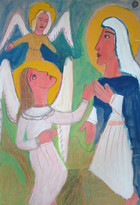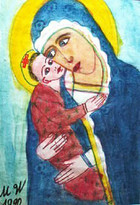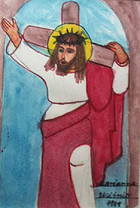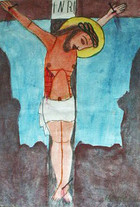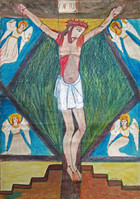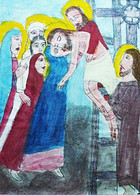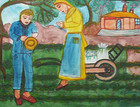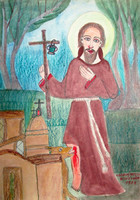Marianna Wisnios
(1909/1914?-1996)
Polish Artist Marianna Wisnios had a lifelong passion to draw. Growing up in a poor peasant family with 11 children (of which seven survived), she never had pencil or crayons, so she used coal and clay. Since they could not afford paper, young Marianna sketched on the white-washed walls, getting a scolding from her mother, who was early widowed and needed her daughter to help work in the fields.
After Marianna married a village barber and had two sons, she was still driven to make art, often working secretly at night. Wisnios would decorate household items, draw in charcoal on fence posts, and color cement bags and sheets of packing paper. Whatever materials she had on hand were good enough for this self-taught artist who never finished elementary school.
Wisnios was discovered in 1972 by her son Paul’s teacher, Anna Grotowska, who suspected the interesting art homework the boy was bringing to class was really done by of one of his parents. Grotowska encouraged Marianna to develop her talents, opening the way for her to take part in folk art exhibitions, where Wisnios' naive studies in watercolor, crayon, pencil, and felt-tip pen picked up top honors.
Wisnios had her first solo show in 1976 at the National Museum in Kielce, and her works soon found their way into folk art museums and private collections around the world. Many of Marianna's paintings can be seen at the Jasna Gora Monastery in Czestochowa, Poland, where pilgrims come by the hundreds of thousands to view the much-revered icon of the Black Madonna.
Wisnios was a woman of deep faith, who considered her artwork to be a form of prayer. She drew whole series of “rosary” pictures to accompany her daily devotions, which she, then, threw away. When deteriorating health forced Wisnios to move in with her son, Norbert, in 1993, she continued to make art until the day she died, three years later, leaving unfinished paintings and sketches on cardboard on her work table.
Her sacred imagery in compelling and contemplative. In simple, austere line drawings and mixed media paintings like Mary Taking Jesus from the Cross, Jesus, and her large-format Crucifixion, Wisnios recreates the Passion of Christ with startling emotional intensity. Other works like In the Field, modeled on French Artist Jean-Francois Millet’s popular painting, Angelus, and Madonna and Child, a variation on Virgin of Tenderness iconography, are informed by a quiet, comforting piety. St. Roch, a mendicant friar who brought healing to victims of the bubonic plague, engages us with his soulful stare.
